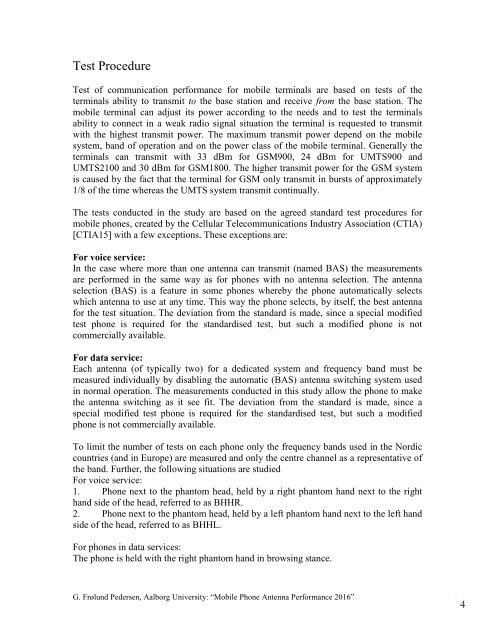You also want an ePaper? Increase the reach of your titles
YUMPU automatically turns print PDFs into web optimized ePapers that Google loves.
Test Procedure<br />
Test of communication performance for mobile terminals are based on tests of the<br />
terminals ability to transmit to the base station and receive from the base station. The<br />
mobile terminal can adjust its power according to the needs and to test the terminals<br />
ability to connect in a weak radio signal situation the terminal is requested to transmit<br />
with the highest transmit power. The maximum transmit power depend on the mobile<br />
system, band of operation and on the power class of the mobile terminal. Generally the<br />
terminals can transmit with 33 dBm for GSM900, 24 dBm for UMTS900 and<br />
UMTS2100 and 30 dBm for GSM1800. The higher transmit power for the GSM system<br />
is caused by the fact that the terminal for GSM only transmit in bursts of approximately<br />
1/8 of the time whereas the UMTS system transmit continually.<br />
The tests conducted in the study are based on the agreed standard test procedures for<br />
mobile phones, created by the Cellular Telecommunications Industry Association (CTIA)<br />
[CTIA15] with a few exceptions. These exceptions are:<br />
For voice service:<br />
In the case where more than one antenna can transmit (named BAS) the measurements<br />
are performed in the same way as for phones with no antenna selection. The antenna<br />
selection (BAS) is a feature in some phones whereby the phone automatically selects<br />
which antenna to use at any time. This way the phone selects, by itself, the best antenna<br />
for the test situation. The deviation from the standard is made, since a special modified<br />
test phone is required for the standardised test, but such a modified phone is not<br />
commercially available.<br />
For data service:<br />
Each antenna (of typically two) for a dedicated system and frequency band must be<br />
measured individually by disabling the automatic (BAS) antenna switching system used<br />
in normal operation. The measurements conducted in this study allow the phone to make<br />
the antenna switching as it see fit. The deviation from the standard is made, since a<br />
special modified test phone is required for the standardised test, but such a modified<br />
phone is not commercially available.<br />
To limit the number of tests on each phone only the frequency bands used in the Nordic<br />
countries (and in Europe) are measured and only the centre channel as a representative of<br />
the band. Further, the following situations are studied<br />
For voice service:<br />
1. <strong>Phone</strong> next to the phantom head, held by a right phantom hand next to the right<br />
hand side of the head, referred to as BHHR.<br />
2. <strong>Phone</strong> next to the phantom head, held by a left phantom hand next to the left hand<br />
side of the head, referred to as BHHL.<br />
For phones in data services:<br />
The phone is held with the right phantom hand in browsing stance.<br />
G. Frølund Pedersen, Aalborg University: “<strong>Mobile</strong> <strong>Phone</strong> <strong>Antenna</strong> <strong>Performance</strong> <strong>2016</strong>”<br />
4



